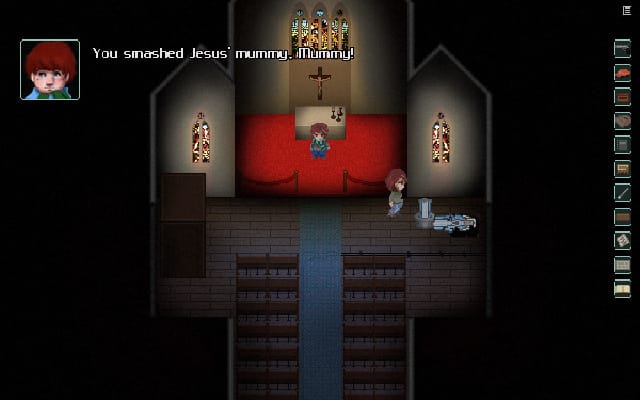
(Review archived from January 19, 2015)
Richard & Alice strikes me as a hybrid mix of point & click adventure meets visual novel. Let’s start out with the high points here. The story of Richard & Alice is absolutely compelling with a particular high note being the well written dialog between characters. The conversational segments in the game flow naturally and realistically. At no point did the dialog seem stilted or poorly written. This is a particularly notable feat when one considers the amount of dialog between Alice and her 5 (and a half!) year old son Barney. It’s hard to write children’s dialog between parent and child in such a way that it seems natural. Most novels can’t get this sort of thing right, let alone the medium of video games. I think you almost have to be a parent yourself in order to effectively write this sort of dialog, and IMO Richard & Alice excels at it. Creating emotional connection between the player and the in game characters is critical to this games success, and thankfully it nails this part.

The game also presents itself as an interesting piece of sci-fi. The near future dystopia has been done to death for ages untold at this point, but Richard & Alice neatly avoids most of the typical tropes and clichés of this setting in that it never waves its world around in your face. The setting here merely serves as a backdrop for the unfolding human drama, but for the most part leaves the concrete dystopian details as part of that backdrop. It’s a largely successful approach as it (rightly, IMO) assumes most players are sophisticated enough to be well versed in the rules of such a world by virtue of previous exposure in the form of other games, film, and books. It effectively tells you what you need to know of the world in order to move the plot along and leaves the rest to imagination.
The gameplay is largely successful but equally does falter in some areas. The point and click adventure elements here are fairly straight forward and rote. There are only three relatively confined areas to explore in the game (four if you’re feeling exceedingly generous). Further, the level of interactivity in these areas is limited in such a way as to effectively move you from point A to point B in the story without a lot of tarrying about. If you’re seeking a richly vibrant, highly interactive point & click title, Richard & Alice is not necessarily going to give you that. The world here exists as a plot device, and the interactive elements within that world are strictly limited to those that serve the plot in some way. So yes, this is a rather tightly wound narrative without the indulgence of unnecessary distractions. Having said that, Richard & Alice incorporates some interesting game mechanics in service to that world and to the general tone of the game. Much has been made of the fact that character movement feels extremely sluggish, and believe me it does, it really, really does. It’s my opinion though, that this was a conscious decision on the part of the developers. The slow movement combined with the relentless sound of the snow ratchets up the tension and anxiety in the game, particularly when there are other characters in peril. It makes the world feel claustrophobic and as if it’s actively working against you. It doesn’t make it any less frustrating mind, but it is ultimately an effective decision.

The one other aspect of the game play that troubles me a bit is that of the multiple endings offered here. There are no less than five possible endings for Richard & Alice, which would seem to indicate the possibility of a branching story line. To be clear on this point, there are absolutely no branches along the way in this story. The ending you get is strictly based on rather arbitrary in-game choices that do not affect the narrative in progress whatsoever. So if you want to see the multiple endings, you’ll play through the exact same story multiple times with the only points of differentiation being the endings themselves. It’s as if you’re reading a Choose Your Own Adventure book in which the only story deviation occurs in the final two pages of the book. Now to be clear the story is excellent, and IMO it does warrant at least one additional play through to pick up on the clues and hints that you may have missed the first time around. But to play through the game five times introduces a sense of drudgery and tedium, particularly when coupled with the slow character movement mentioned above. More damningly it also reduces some of the emotional wallop present in the game with each additional playthrough. Accordingly, if you’re going for multiple playthroughs I’d recommend taking a suitable cool down period in betwixt.
I’d recommend this game to fans of visual novels (slightly more so than fans of adventure games), as well as to anyone who appreciates quality storytelling coupled with quality characterization in games, especially so this latter element.
Leave a Reply